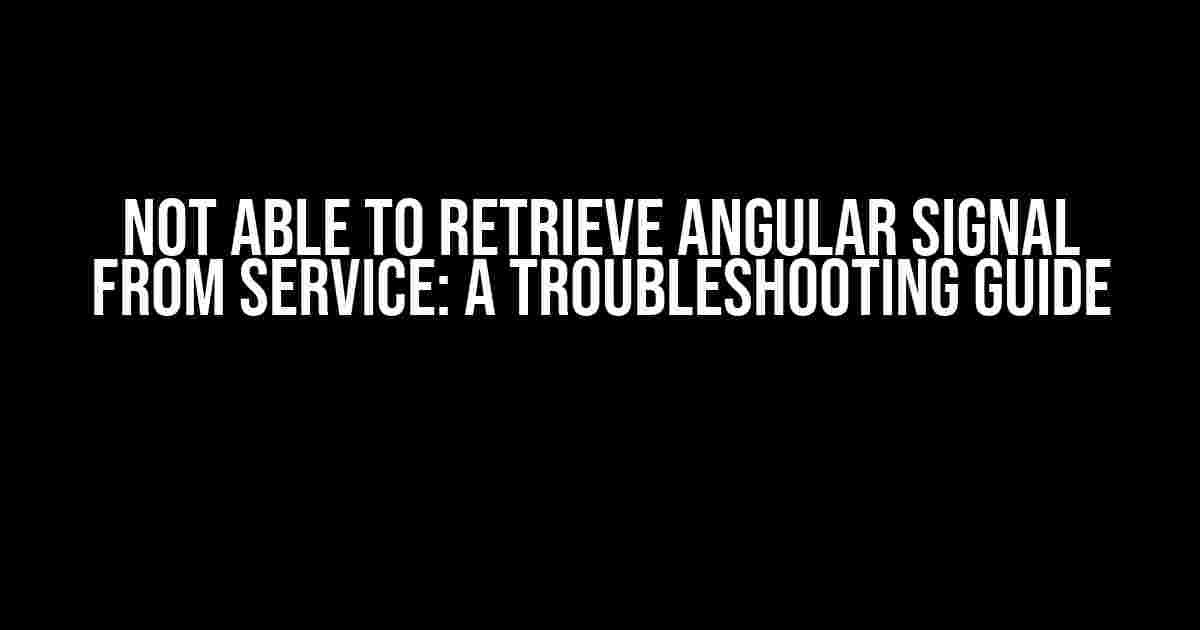If you’re reading this article, chances are you’re stuck in the frustrating situation where your Angular application is not able to retrieve a signal from a service. Don’t worry, you’re not alone! In this comprehensive guide, we’ll take you by the hand and walk you through the most common causes and solutions to this issue.
Understanding the Basics
Before we dive into the troubleshooting process, let’s quickly review the basics of Angular services and signal retrieval.
What is an Angular Service?
In Angular, a service is a singleton object that provides some functionality to components. Services are typically used to share data between components, perform complex logic, or interact with external APIs.
What is a Signal in Angular?
A signal in Angular refers to a notification or event emitted by a service that notifies components of changes or updates. Signals are often used to update the UI or trigger actions in response to changes in the application state.
Troubleshooting Steps
Now that we’ve covered the basics, let’s move on to the troubleshooting steps to help you retrieve the Angular signal from your service.
Step 1: Check the Service Implementation
The first step is to review the implementation of your service. Make sure that:
- The service is properly injected into the component using the constructor.
- The service is importing the necessary modules and providers.
- The service is using the correct syntax to emit the signal (e.g., `next()` or `emit()`).
import { Injectable } from '@angular/core';
import { Subject } from 'rxjs';
@Injectable({
providedIn: 'root'
})
export class MyService {
private signal = new Subject<any>();
constructor() { }
emitSignal(data: any) {
this.signal.next(data);
}
getSignal(): Observable<any> {
return this.signal.asObservable();
}
}
Step 2: Verify Component Subscription
Next, ensure that the component is properly subscribed to the signal.
Check that:
- The component is importing the service and injecting it into the constructor.
- The component is subscribing to the signal using the `subscribe()` method.
- The component is handling the signal correctly (e.g., updating the UI or triggering actions).
import { Component, OnInit } from '@angular/core';
import { MyService } from './my.service';
@Component({
selector: 'app-my-component',
template: '<div></div>'
})
export class MyComponent implements OnInit {
constructor(private myService: MyService) { }
ngOnInit(): void {
this.myService.getSignal().subscribe((data: any) => {
console.log('Received signal:', data);
// Update the UI or trigger actions
});
}
}
Step 3: Inspect the Signal Flow
If the service and component implementations look correct, it’s time to inspect the signal flow.
Use the Angular DevTools or a debugging tool like Augury to:
- Verify that the service is emitting the signal correctly.
- Check that the component is receiving the signal and subscribing to it correctly.
- Inspect the signal data to ensure it’s what you expect.
| Tool | Feature | Description |
|---|---|---|
| Angular DevTools | Component Tree | Visualize the component hierarchy and inspect the component properties. |
| Angular DevTools | Dependency Graph | Inspect the dependency graph to ensure the service is correctly injected. |
| Augury | Component Inspector | Inspect the component properties, including the signal subscription. |
Step 4: Check for Interceptor or Middleware Issues
If the signal is being emitted correctly, but the component is not receiving it, check for any interceptors or middleware that might be interfering with the signal flow.
Review your application’s interceptor and middleware implementations to ensure they’re not:
- Blocking or modifying the signal.
- Adding unnecessary delays or timeouts.
- Causing conflicts with other services or components.
import { Injectable } from '@angular/core';
import { HttpInterceptor } from '@angular/common/http';
@Injectable()
export class MyInterceptor implements HttpInterceptor {
intercept(request: HttpRequest<any>, next: HttpHandler): Observable<HttpEvent<any>> {
// Ensure the interceptor is not modifying or blocking the signal
return next.handle(request);
}
}
Step 5: Review the Application Configuration
If all else fails, review your application’s configuration to ensure that:
- The service is correctly configured in the module providers.
- The component is correctly declared in the module declarations.
- There are no conflicts between different versions of Angular or dependencies.
import { NgModule } from '@angular/core';
import { MyService } from './my.service';
import { MyComponent } from './my.component';
@NgModule({
declarations: [MyComponent],
imports: [],
providers: [MyService],
bootstrap: [MyComponent]
})
export class AppModule {}
Conclusion
Troubleshooting the “Not able to retrieve Angular signal from service” issue can be challenging, but by following these steps, you should be able to identify and resolve the underlying cause. Remember to:
- Verify the service implementation and signal emission.
- Check the component subscription and signal handling.
- Inspect the signal flow using Angular DevTools or Augury.
- Review interceptor and middleware implementations.
- Ensure correct application configuration.
By methodically working through these steps, you’ll be able to retrieve the Angular signal from your service and get your application working as intended.
Additional Resources
If you’re still struggling to resolve the issue, consider exploring these additional resources:
- Angular Official Documentation: https://angular.io/docs
- Angular DevTools: https://angular.io/guide/devtools
- Augury: https://augury.rangle.io/
- Stack Overflow: https://stackoverflow.com/questions/tagged/angular
Remember, troubleshooting is an iterative process, and patience is key. Take your time, stay calm, and you’ll eventually resolve the issue and get your Angular application working smoothly.
Here are 5 Questions and Answers about “Not able to retrieve Angular signal from service”:
Frequently Asked Question
Stuck while retrieving Angular signal from service? Don’t worry, we’ve got you covered!
Why am I not able to retrieve Angular signal from service?
This might be due to a timing issue, where the signal is not yet available when your component tries to retrieve it. Make sure to use the async pipe or subscribe to the observable to get the latest value.
How do I debug my Angular service to see if it’s sending the signal correctly?
Use the Angular debugging tools or add console logs to your service to see if the signal is being sent correctly. You can also use the Angular DevTools to inspect the service instance and its properties.
What if I’m using a third-party library to send the signal, and it’s not working with my Angular app?
Check the library’s documentation to see if it’s compatible with Angular, and if it provides any specific integration instructions. You might need to wrap the library’s API with an Angular service or use a bridge to make it work with your app.
Should I use a singleton service or a component-scoped service to send the signal?
It depends on your use case. A singleton service is suitable if the signal needs to be shared across multiple components, while a component-scoped service is better if the signal is only relevant to a specific component or module.
What are some best practices to keep in mind when working with Angular services and signals?
Keep your services simple and focused on a specific task, inject them correctly into your components, and use Observables or Subjects to handle the signal communication. Also, avoid using services as a global state management system; instead, use a dedicated state management solution like NgRx or Akita.




